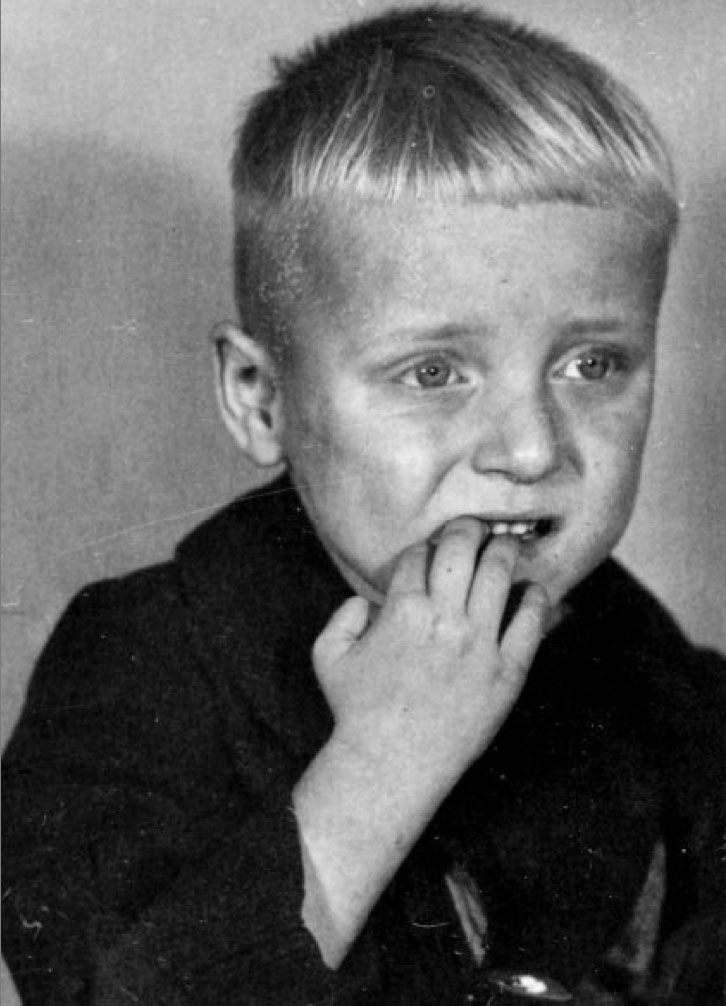Search for Names, Places and Biographies
Already layed Stumbling Stones
Suche
Klaus Peter Wörbach * 1938
Tarpenbekstraße 107 (Hamburg-Nord, Eppendorf)
HIER WOHNTE
KLAUS PETER
WÖRBACH
JG. 1938
EINGEWIESEN 1942
ALSTERDORFER ANSTALTEN
´VERLEGT‘ 7.8.1943
HEILANSTALT
KALMENHOF/IDSTEIN
ERMORDET 7.9.1943
further stumbling stones in Tarpenbekstraße 107:
Günther Blobel, Josephine Boock
Klaus Peter Wörbach, born 17.4.1938 in Altona, admitted to the Alsterdorf Asylum (Alsterdorfer Anstalten, now Evangelische Stiftung Alsterdorf) on 17.7.1942, transported to the Curative Education Institution Kalmenhof (Heilerziehungsanstalt Kalmenhof) near Idstein in the Rheingau on 7.8.1943, died there on 16.8.1943.
Tarpenbekstraße 107, (entrance to Anscharhöhe Foundation), Eppendorf
Klaus Peter Wörbach was born on 17 Apr. 1938 in the Hamburg district of Altona. His mother Hildegard Wörbach, born on 21 May 1909 in Öhringen (Hohenlohekreis/Baden-Württemberg) was single at the time of her son's birth. She did not marry Klaus Peter’s natural father Walter Skozeba. Hildegard Wörbach later married a man named Schiemer. This marriage was divorced.
Klaus Peter Wörbach was born five weeks before the calculated date of birth. According to a report by the State Youth Welfare Office (Landesjugendamt), the mother is said to have hardly cared for the child. She moved to Lübeck in July 1941.
The boy lived in the children's home at Bahrenfelder Kirchenweg 51, until he was admitted to the Mutter Langer House of the Anscharhöhe Diaconal Institution on Tarpenbekstraße in Hamburg-Eppendorf in October 1940.
He did not learn to walk until January 1941, when he was almost 2 1⁄2 years old. The Anscharhöhe home management wrote in the only preserved report about the child on 28 Jan. 1942: ”Klaus Peter Wörbach is mentally and physically behind his age. He walks alone, albeit very fearfully. He sometimes says a word without meaning or context. He makes an uninterested impression. He has a good ear for melodies, he hums them correctly, but breaks off in the middle and lets out strange cries. He plays quite cutely on his own, but pointlessly. He observes his surroundings, but is not active himself. He gives the impression of a completely abnormal child. He still wets and soils himself."
In April 1942, the Youth Welfare Office suggested that Klaus Peter Wörbach should be "transferred to the Alsterdorf Asylum”. He was admitted there on 17 July 1942. According to the entries in his patient file, he could not yet speak and was described as a very restless child who cried a lot and could not announce his needs. In June 1943, the five-year-old boy came into the male section of the asylum, House Karlsruh. There are no entries about care or support measures, giving the impression that the boy was merely "kept" as suggested.
During the air raids on Hamburg in July/August 1943, parts of the Alsterdorf Asylum were also destroyed. Between 7 and 16 August, after an agreement between the institution management and the Hamburg health administration, a total of 468 girls and women, boys and men were transferred in three transports to the Eichberg Institution (Landesheilanstalt Eichberg) near Wiesbaden, to the Curative Education Institution Kalmenhof in Idstein in the Rheingau, to the Sanatorium and Nursing Home Mainkofen (Heil- und Pflegeanstalt Mainkofen) near Passau and to Vienna to the Wagner von Jauregg – Curative and Nursing Home of the City of Vienna (Wagner von Jauregg-Heil- und Pflegeanstalt der Stadt Wien, also known as the institution "Am Steinhof").
The first transport took place on 7 Aug. 1943 with a total of 76 girls, women, boys and men to the Eichberg sanatorium and nursing home in the Rheingau and with 52 boys and men to the Kalmenhof sanatorium near Idstein. Klaus Peter Wörbach was among those deported to the Kalmenhof.
The Kalmenhof, founded in 1888, had originally acquired a good reputation as a progressive institution for people with mental disabilities, but had then been included into the National Socialists' "Euthanasia"-programme, initially as an intermediate institution for the Hadamar killing centre during the first "Euthanasia” phase until August 1941. Afterwards, murder took place in the Kalmenhof itself, among others in the "children's specialist department" established at the end of 1941. In about 30 of such "children's specialist departments" ("Kinderfachabteilungen") in the German Reich, children aged up to three years, and later up to sixteen years, were murdered, mostly by deprivation of food and overdosed medication such as morphine, Luminal or scopolamine.
No health restrictions were documented about Klaus Peter Wörbach. Nevertheless, he died there on 16 Aug. 1943, only nine days after his arrival. His death was registered at the responsible registry office following a written report by the manager of the Kalmenhof. The cause of death was given as "debility, nutritional disorder, marasmus". Marasmus means progressive deterioration of physical and mental strength, among other things due to malnutrition. So it can be safely assumed that Klaus Peter Wörbach did not die of natural causes.
Klaus Peter Wörbach lived in the Anscharhöhe Diaconal Institution for a longer period of his short life. As far as can be seen, the staff there cared for him and did not regard him merely as a "case of preservation". This is why the Stolperstein in memory of him was placed in the entrance area of the Anscharhöhe.
Translastion: Elisabeth Wendland
Stand: August 2023
© Ingo Wille
Quellen: Evangelische Stiftung Alsterdorf, Archiv, Bewohnerakte V 87 (Klaus Peter Wörbach). Stadtarchiv Idstein, Sterberegisterauszug Nr. 152/1943. Michael Wunder, Ingrid Genkel, Harald Jenner, Auf dieser schiefen Ebene gibt es kein Halten mehr – Die Alsterdorfer Anstalten im Nationalsozialismus, Stuttgart 2016, S. 283 ff., 289 ff.


